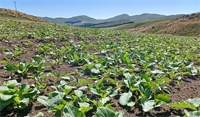Essential steps for protecting young stock
THIS PROMOTIONAL FEATURE WAS PROVIDED BY AGRITRADE
Now spring is here, and we have another winter under our belts it is time to welcome some sunshine and spring grass growth to keep the cows milking and the calves growing. It’s not only us farmers, our stock and the pasture that enjoy some warmer spring weather, the parasites do too and now is a good time to reassess your young stock drench programme.
Growing young stock well is essential for lifelong performance in the dairy herd, and parasites can be a leading cause of poor growth rates in young cattle if they are not well managed.
When considering calf drenches three factors need to be considered.
• Calf weight: Calves under 100kg are susceptible to Abamectin toxicity so drench combinations including this should not be used in this weight group.
• Age: cattle under 12 months require Levamisole to target Cooperia worms, so all calf drenches must contain this drench component.
• Oral drench is best.
For calves that have been on pasture for 4 weeks or more and require their first drench, consider Active + Merge, a 1mL/10kg oral drench of Oxfendazole and Levamisole. Merge is a safe and effective choice for calves under 100kg. After weaning and when calves are greater than 100kg, a triple combination oral drench, such as Active + Treble, is recommended. Heifers being mated for the first time may also require a spring drench for parasites to help achieve the best condition and hit mating target weights (Dairy NZ recommends 60% of mature cow LW at mating). When choosing a drench for this stock class, an injection is preferable over pour-on, but opt for one containing an ML drench to target Ostertagia, such as Horizon Doraject injection containing Doramectin. R2 bulls should also be included in this treatment group.
Should any light cows or first calvers require a parasite knock down premating Active + Epi has a convenient nil milk withhold so it can be easily given prior to PSM.
As always, when drenching stock, it is important to weigh a sample of the mob and drench to the heaviest animal. Calibrating your drench guns using the drench you intend to use, and reliable measuring cylinders is also an essential component of drenching, as under or overdosing can be costly mistakes that are easily avoidable.
As drench resistance becomes more prevalent, we recommend taking a 10-day post-drench faecal egg count to monitor the effectiveness of your drenches. Ensuring a minimum of 28 days between drenches is important to give time in the worm life cycle for a population of “undrenched worms” to be present for refugia and aids in slowing the progression of resistance. Where possible using forage crops, cross grazing with other species and maintaining high grazing residuals are all good tools for reducing larval intake and lowering the need for drenches.
Maintaining overall calf health enables calves to build a strong immune system and tolerate a mild worm burden so again there is less reliance on drench to prevent parasitism. Multimineral injections such as Horizon InjectaMin or InjectaMax (with B12) help boost the immune system and can be given up to every three months to help boost young stock growth especially at times of stress such as weaning.
These multimineral injections also benefit cows and heifers prior to mating by boosting their immune systems with Zinc, Selenium, Copper, Manganese, and B12 which are all essential for a robust immune system and fertility. Copper and Selenium can both be toxic when given in excess so if you have already supplemented copper via a bullet or injection and want a Copper-free option for a premating boost, consider Horizon Cobalject B12 (1000 or 2000) injection that has the option of additional Selenium.
To build a drench programme for your young stock this spring and to get the best out of your cows this coming mating, talk to your Ruralco representative or visit your local store today.
ACVM #s: A011494, A011925, A011491, A011495, A011926, A010717, A011690, A011692, A011694 & A011969
Back to Real Farmer
Related

Corteva Agriscience leverages global research and local knowledge of forage brassica production in N...
Read More

For over three decades, Ngahiwi Farms has been synonymous with quality in the calf milk replacer (CM...
Read More